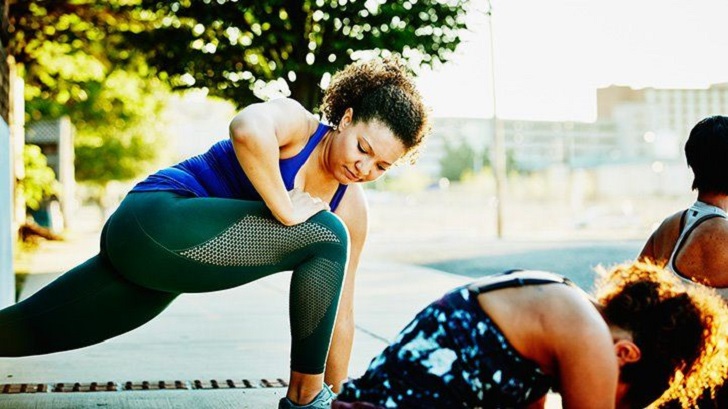
Stretching: Health Benefits, and Getting Started

Stretching is essential to any exercise routine and can be done as a standalone activity. It involves moving your muscles and joints through various motions to increase flexibility, reduce muscle tension, and improve overall mobility.
Stretching can be performed before and after exercise or anytime throughout the day to help promote good posture, reduce stress, and improve circulation. This article will discuss stretching, its health benefits, and how to get started.
What Is Stretching?

Thomas Barwick/ GettyImages | You are only as young as your spine is flexible
Stretching involves moving the muscles and joints in your body through a range of motions. It can be done statically, by holding a position for a certain amount of time, or dynamically by moving in and out of a stretch. There are many different types of stretches, including:
- Static stretching: holding a position for 10-30 seconds
- Dynamic stretching: moving in and out of a stretch
- PNF stretching: involves contracting and relaxing the muscle during the stretch
- Active stretching: uses the muscles opposite the target muscle to facilitate the stretch
- Passive stretching: uses a partner or external force to assist in the stretch
What Are the Health Benefits of Stretching?
Improved Flexibility
Stretching can help increase your range of motion and flexibility, reducing the risk of injury during physical activity.
Reduced Muscle Tension
It can also reduce pain and improve circulation, reducing muscle tension and increasing blood flow.
Improved Posture
Stretching can help improve your posture by lengthening tight muscles and strengthening weak ones.

Gretchen Reynolds/ Getty Images | Your life is worth a lot more than you think
Reduced Stress
By stretching, you reduce stress by promoting relaxation and reducing tension in the body.
Improved Athletic Performance
Stretching before and after exercise can help improve athletic performance by increasing flexibility and reducing the risk of injury.
Getting Started With Stretching
Start Slow
It’s important to start slowly and gradually increase the intensity and duration of your stretches over time. If you’re new to stretching, start with a few simple stretches and gradually work up to more advanced ones.
Warm Up First
Before stretching, you should always warm up your muscles to reduce the risk of injury. This can be done by performing a light aerobic activity or dynamic stretching.
Stretch All Major Muscle Groups
Stretching all major muscle groups, including your arms, legs, back, and neck, is crucial. This will help ensure that your entire body is flexible and mobile.

Thomas Barwick/ GettyImages | Stretching every day keeps the sore muscles away
Hold Each Stretch for At Least 10-30 Seconds
Hold each stretch for at least 10-30 seconds to benefit most from your stretches. This will give your muscles time to relax and lengthen.
Don’t Push Too Hard
Listen to your body, and do not push too hard when stretching. You should feel a mild stretch but not pain.
Breathe Deeply
It’s important to breathe deeply and rhythmically while stretching. This will help promote relaxation and reduce tension in the body.
Stretch Regularly
Try stretching into your daily routine, before or after exercise or anytime throughout the day.
More in Nutrition & Weight Loss
-
`
Hair & Makeup Designer Sarah Rubano Talks Turning Mia Goth Into Pearl
Transforming an actor into an unrecognizable character is no small feat, and Mia Goth’s Pearl makeup in the hit movie “Pearl”...
December 17, 2024 -
`
The Physical Signs of Hunger and How Mindful Eating Makes a Difference
Hunger is one of the most basic yet essential signals our body uses to communicate its need for energy. However, many...
December 15, 2024 -
`
Why Did Chris Pratt Call Anna Faris Before Proposing to Katherine?
Chris Pratt, the beloved star of “Guardians of the Galaxy,” made headlines when he revealed that he called his ex-wife, Anna...
December 3, 2024 -
`
6 Proven Tips to Tackle Insurance Claim Denials Successfully
Claim denials are a common hurdle for healthcare providers and professionals, even for those who follow the necessary procedures to avoid...
December 1, 2024 -
`
5 ‘Bad’ Fitness TikTok Trends You Shouldn’t Follow
TikTok has become a haven for creative fitness advice. But not all trends are worth your time or your health. From...
November 23, 2024 -
`
Does Drinking Water Affect Adrenal Hormones?
Drinking water is often seen as a simple way to stay hydrated, but it has deeper effects on our body than...
November 14, 2024 -
`
Why We Feel the Loss of Celebrities So Deeply?
Celebrity grief might sound strange at first. After all, most of us have never met these famous figures in person, yet...
November 5, 2024 -
`
Are High Deductible Insurance Plans as Ideal as They Appear to Be?
High deductible insurance plans have been a hot topic for years, especially as healthcare costs continue to rise. For many Americans,...
October 31, 2024 -
`
How Training Load Data Can Transform Your Exercise Routine
Tracking progress during workouts is challenging. Simple metrics like mileage or time don’t show the whole picture. Understanding the overall effort...
October 26, 2024















You must be logged in to post a comment Login